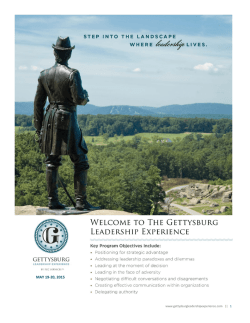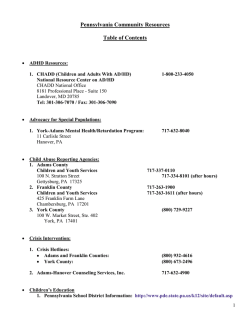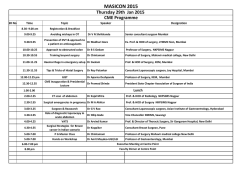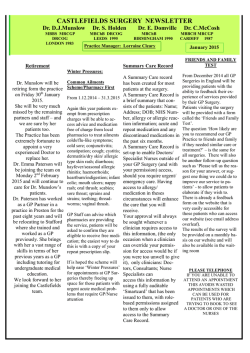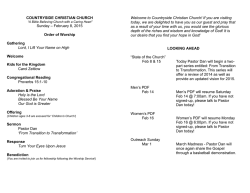
Newsletter - Mahoning Valley Civil War Round Table
DATE: LOCATION: SPEAKER: Gordy Morgan, Editor E-mail - [email protected] Dave Duchek, Publisher mahoningvalleycwrt.com Monday, February 9, 2015 @ 6:30 P.M. Antone’s, 8578 Market Street, Boardman, Ohio Dan Welch, Gettysburg Foundation and MVCWRT member Gettysburg Experiences If I were to ask our members if “Living the Dream” meant attending Gettysburg College, interning at Gettysburg NMP, and conducting battlefield tours as a Park Ranger there, I bet I’d get a resounding, “YES!” But that’s exactly what our February speaker has been up to these past few years. Dan Welch’s introduction to our passion is familiar to many: a family trip to Gettysburg as a youngster. “Every time my father or mother asked where I wanted to go for next year’s family vacation,” he says, “it was always the same response, Gettysburg.” After graduating from Canfield HS, Dan enrolled in the Instrumental Music Education program at Youngstown State’s Dana School of Music where he earned his Bachelor’s degree. In 2005, he took a short break from studying music to enroll in the Gettysburg Semester at Gettysburg College, a semester-long immersion in Civil War Era Studies, where he applied his mind to the acquisition of knowledge under the distinguished scholar Dr. Allen C. Guelzo. He currently serves as the Education Programs Coordinator for the Gettysburg Foundation, the nonprofit partner of the Gettysburg NMP, but for five years previous worked as a seasonal Park Ranger conducting campaign and battle programs for school groups, families, and visitors of all ages. Most recently, Dan was involved in planning Gettysburg’s special 150th anniversary programs as well as giving talks for the Mid-Winter Lecture series. He’s currently finishing an MA in Military History with a Civil War-Ear concentration at American Military University. Dan has been very active in planning tours for our group and organized and implemented our Battlefield Donation Program. He and his wife, Sarah, sell used books at the meeting to aid that endeavor. “After Gettysburg: Confederate Retreat and Return” will be the theme of our spring tours the weekend of April 24-26. Battlefield guides and our dear friends, Rob Orrison and Matt Atkinson, along with our own Dan Welch, will lead us on a three-day sketch of the 1863 Confederate retreat from Gettysburg and Jubal Early’s return to Pennsylvania a year later. On Friday, we’ll tour Monocacy Battlefield, and on Saturday, it’s back to Gettysburg for tours of Seminary Ridge, Fairfield, Monterey Pass, Hagerstown, and Falling Water. We’ll conclude on Sunday with the 1864 Raid on Chambersburg. The cost is $45 per person. We haven’t reserved a hotel, but we’ll be HQ’d in Gettysburg. We’ll have more details at the February meeting. 1 By Charen Fink During the Civil War soldiers and civilians alike recovered medically mainly due to their own stamina. Had the war been fought thirty years later so many more people would have lived. This was the first war in which medicine was well reported and analyzed. Some more “Never Befores”: Medical activities well-reported and analyzed Collection of pathological specimens for a museum Vast experiment in what the human body could endure without “support” The Doctors Most poorly trained Some ex-apprentices with no formal education Most granted M.D. after three-year apprenticeships plus a year of medical school work No postgraduate training A man adept with his hands became a surgeon Still, there were many able surgeons despite the simple surgery of the time Wound Dressings Minor surgery involved dressing wounds with lint, as cotton was less popular and used only on large wounds and burns Bandaging was an art form. Fractures were set with metal splints and custom-made wooden splints Plaster of Paris became popular because of a shortage of whittlers of wooden ones Now Discarded Treatments Local irritation with the use of Spanish Fly blister For concussion or collapse: scalding water, flaming alcohol paper, glowing cautery iron Pain relief used the moxa, a wad of cotton, which by means of a bellows, the doctor caused to burn onto the skin over the painful area. First there was a sense of pleasant heat, then excruciating pain, and then relief as the skin was destroyed Treatment for pneumonia was “cupping,” in which a heated glass cup was inverted upon the chest until a blister formed. This was lanced and the cup reapplied until an ounce of blood was drawn off. The resultant pain made the soldier forget his original illness. Fortunately this practice was seldom used by either army and ended after the war Types of Surgeries Amputations, breast surgery, and occasional abdominal surgeries included: removal of ovarian cysts, some hysterectomies, and rarely a Caesarian. The latter resulted in 80% mortality Bowel surgery was only for repair of a rent Hernia repairs often ended in infection 2 Emphasis on Speed Before the advent of anesthetics, speed was crucial. Limbs could be removed in 2 ½ to 3 minutes; 16 minutes for a breast Jonathan LetterReference Jones, Dr. Gordon W. “Wartime Surgery.” Civil War Times Illustrated, May 1963, pgs. 7‐9 and 28‐30. man established the divisional hospital system; the entire medical team was concentrated in one spot caring for those from any regiment rather than surgeons assigned to one regiment Anesthesia was used in civilian practice for 14 years before the war broke out Chloroform (76% used) and ether (15% used) were both available, but ether was flammable Antisepsis vs Asepsis Women fostered cleanliness, but surgeons ignored this as womanish notions Some surgeons honed their knives on the soles of their shoes There was a lack of understanding about germs Penetrating chest wounds brought 73% mortality and abdominal wounds, 74% mortality There was a high fatality rate with head wounds with 80% mortality if penetration or perforation Flesh Wounds Treated with cold water and opiates The area of orthopedic surgery made great strides during the war but there was also much exaggeration as to the number of amputations performed. Among the 10,000 wounded during Sheridan’s Valley Campaign, there were only 338 amputations which included any body part. Dr. Letterman wanted only experienced surgeons doing this. The Red Cross, hospital design, and the U.S. Sanitary Commission were a few advancements resulting from the tragedies of war. General Louis Addison Armistead, contributed by Bob Schneider: Louis Armistead’s father in September of 1814 Major George Armistead was the Commander of Fort McHenry in Baltimore Harbor during the war of 1812. Fearing the British attack on the city of Baltimore, the Major shipped his family north to a little crossroads town in Pennsylvania. That little crossroads was Gettysburg, Pennsylvania, where on July 5, 1863 Confederate Brigadier General (CSA) died at age 46. It was also at Fort McHenry during the battle that inspired Francis Scott Key to write the Star Spangled Banner that latter became our National Anthem. Louis Armistead was born in New Bern, North Carolina, died in Gettysburg, Pennsylvania, at the Angle during Pickett’s Charge. Armistead is buried at Old Saint Paul’s Cemetery in Baltimore, Maryland. 3 WHAT ARE SOME OF OUR MEMBERS READING? Dan Welch: Over the past several years, I have branched further away from reading only about the American Civil War. Although my time in this topic has dwindled, other military history works that I have tackled have not only been enlightening, but also have increased my understanding of the events of 150 years ago. One book I am making my way through is The Boys of '67: Charlie Company's War in Vietnam by Andrew Wiest. The book chronicles the 160 men of Charlie Company (4th Battalion/47th Infantry/9th ID) that were drafted by the US Army in May 1966. By December 1967, when the company rotated home, only 30 men were not casualties—and they were among the first vets of the war to be spit on and harassed by war protestors as they arrived back in the U.S. This is a great book that has an outstanding companion documentary by National Geographic that includes dozens of interviews with surviving veterans of Charlie Company. I just recently finished an engaging study of the battle of Wanat written by the Staff of the US Army Combat Studies Institute. The Battle of Wanat occurred on July 13, 2008, when about 200 Taliban and al-Qaeda guerrillas attacked NATO troops near Quam, in the Waygal district in Afghanistan's far eastern province of Nuristan. The position was defended primarily by United States Army soldiers of the 2nd Platoon, Charlie Company, 2nd Battalion, 503rd Infantry Regiment (Airborne), 173rd Airborne Brigade Combat Team. The Battle of Wanat has been described as one of the bloodiest Taliban attacks of the war and one of several attacks on remote outposts. I also just finished, in time for the sesquicentennial, An Honorable Defeat: The Last Days of the Confederate Government by William C. Davis. This is a fascinating narrative following the Confederate government's escape from Richmond, arduous journey southward, and slow dissolution by key members leaving along the way. It provides great insight into the men who held the Confederacy together in its waning days. The narrative is fast-paced and engaging, making you completely forget its hefty length. Gordy Morgan: Like Dan, I, too, am branching out, but I’m venturing away somewhat from military history into fiction. The last book I read, Water for Elephants, was recommended by a friend as part of a “2015 Reading Challenge” I saw on Facebook. My wife liked it; me? Not so much. Before that, I read George R. R. Martin’s A Game of Thrones, which is part of his five-part fantasy series A Song of Fire and Ice. You need a scorecard to keep track of the characters, but Martin has an impressive command of the English language and the story is intriguing. Before starting it, though, my niece warned me not to get too attached to any of the characters. If you’re familiar with the story or the HBO series, I don’t have to explain why. Right now, I’m reading And Then There Were None, an Agatha Christie mystery that my wife downloaded for free to her Nook digital reader. I started it because it’s very short. I haven’t completely neglected Civil War history, though. At the same time I was wading through the more than 630 pages of A Game of Thrones, I managed to fit in Backstage at the Lincoln Assassination by Thomas A. Bogar, which is a unique look at an oft-told story. I highly recommend it. Next, I’ll take Dave Frank’s advice and pick up General Grant and the Rewriting of History by Frank P. Varney. 4
© Copyright 2026
